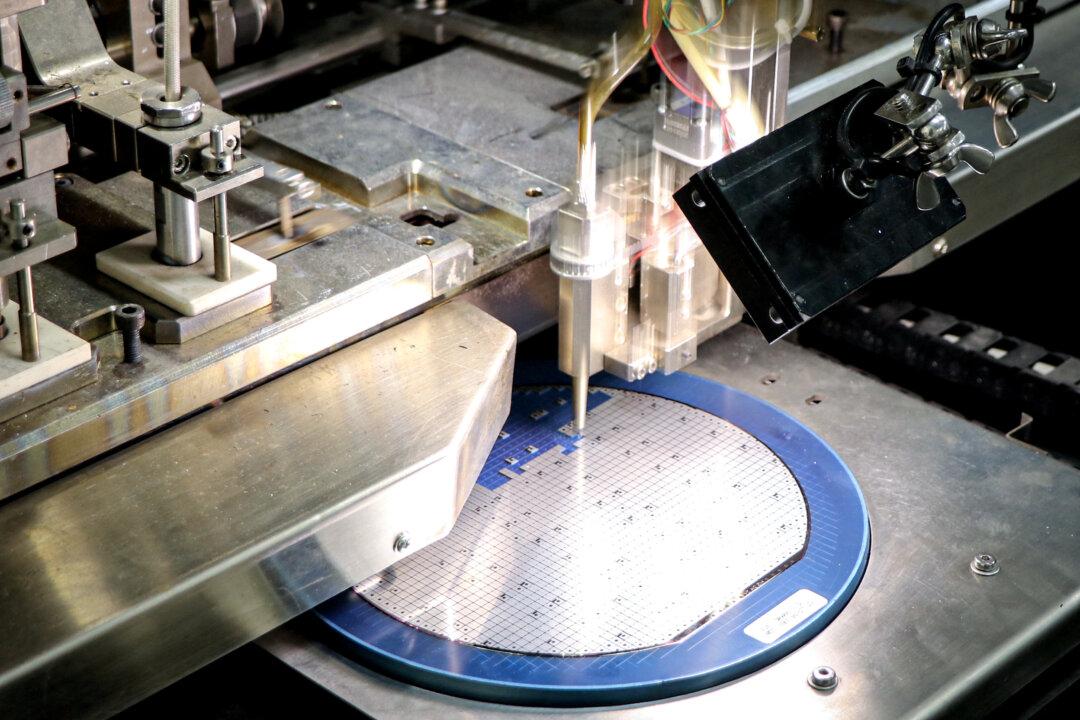President Donald Trump said on April 13 that he would announce a new nonnegotiable tariff rate for imported semiconductors within the next week.
Trump, speaking to reporters aboard Air Force One while returning to Washington from his home in Palm Beach, Florida, said: “Like we did with steel, like we did with automobiles, like we did with aluminum, which are now fully on, we'll be doing that with semiconductors, with chips and numerous other things. And that will take place in the very near future.
“We wanted to uncomplicate it,” he said, referring to the industry-specific tariffs. “Because we want to make our chips and semiconductors and other things in our country.”
Earlier on April 13, in a social media post, the president said: “Nobody is getting ‘off the hook’ for the unfair trade balances, and non-monetary tariff barriers, that other countries have used against us, especially not China.
“There was no Tariff ‘exception’ announced on [April 11]. These products are subject to the existing 20 percent Fentanyl Tariffs, and they are just moving to a different Tariff ‘bucket.’”
He also announced a national security trade probe into the semiconductor sector.
“We are taking a look at Semiconductors and the WHOLE ELECTRONICS SUPPLY CHAIN in the upcoming National Security Tariff Investigations,” he wrote.
The president said another bucket of tariffs is being designed to address national security issues in the pharmaceutical supply chain.
“We want to make our drugs in this country, and by placing a tariff on the companies that are not in this country. ... We’re going to have our drugs made in the United States so that in case of war, in case of whatever, we’re not relying on China and various other countries.”
On April 13, Commerce Secretary Howard Lutnick said on ABC’s “This Week” that the range of electronic product imports will fall under the separate tariff plans that focus on semiconductors.
Lutnick told ABC’s Jonathan Karl that Trump’s announcement on April 11 only exempted those items from reciprocal tariffs.
“But they’re included in the semiconductor tariffs, which are coming in probably a month or two,” Lutnick said.
Speaking with NBC’s “Meet the Press” on April 13, White House senior counselor and trade adviser Peter Navarro said the tariffs will be determined through an investigation of the chips supply chain, launched under Section 232 of the Trade Expansion Act of 1962.
That act allows the president to restrict imports considered a threat to national security. The copper and timber industries have already seen Section 232 investigations by Trump over the past two months, and the president used the results of one 232 investigation from his first term to defend increasing aluminum and steel tariffs in March.
After Trump’s announcement in early April of universal 10 percent tariffs on every U.S. trading partner, along with separate reciprocal tariffs for some, global and domestic stock markets experienced turbulence. The president then paused almost all of his tariffs for 90 days after declaring that he is brokering trade deals with numerous partners, but he raised tariffs on Chinese imports to 145 percent.
After the S&P 500 initially dropped upon the unveiling of the April 2 tariff plan, the index rose by 9.5 percent on April 9—its highest single-day gain since October 2008—after Trump announced his 90-day pause on most tariffs. The index, however, was still 11.2 percent below a recent high in February.
While many of the president’s tariffs are open to negotiation, Lutnick emphasized that semiconductor-based technology products were exempted on April 11 precisely because they are nonnegotiable.
“So this is not a permanent sort of exemption,” he said. “[Trump is] just clarifying that these are not available to be negotiated away by countries.”
Lutnick said tariffs on semiconductors and pharmaceuticals are necessary to incentivize the reshoring of their production back to the United States.
“We need our medicines, and we need semiconductors and our electronics to be built in America,” he said.
“We can’t be beholden and rely upon foreign countries for fundamental things that we need. We can’t be relying on China for fundamental things that we need.”
Biden cited the need to reduce the United States’ reliance on China for sourcing semiconductors, which are essential to a wide range of consumer electronics, while also supporting U.S. jobs.
Lutnick echoed those concerns on April 13.
“We need to have semiconductors,” he said. “We need to have chips, and we need to have flat panels. We need to have these things made in America. We can’t be reliant on Southeast Asia for all of the things that operate for us. Virtually all semiconductors are made now in Taiwan, and they’re finished in China.”
Karl, noting that it would be unlikely that Apple opens a factory “tomorrow” to build iPhones in the United States, asked Lutnick whether the new tariffs will lead to higher prices, as some companies, such as AutoZone and Amazon, have already publicly indicated.
“I don’t necessarily think so,” Lutnick said, noting that Panasonic had just finished building a new factory in Kansas. “I think the idea is that we can manufacture here in America.
“They made deals with the community colleges nearby and all the local community. They trained people for this—4,000 high-tech jobs in Kansas.
“That is what’s coming back to America. ... That kind of high-tech factor is going to produce things here at very reasonable prices.”
Sen. Elizabeth Warren (D-Mass.), who spoke with Karl after Lutnick did, said she wants Congress to be able to approve or block tariffs imposed by the president.
“Every Democrat is ready to go, to push back or take away from the president the power he’s now exercising,” she said. “The question is whether or not the Republicans will join us in this. There will be a vote in about 15 days.”







